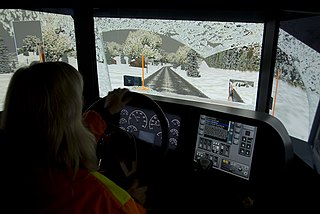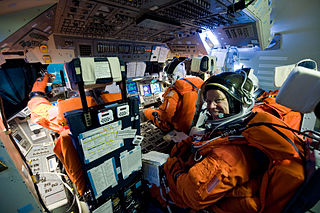The Cockpit display systems (or CDS) provides the visible (and audible) portion of the Human Machine Interface (HMI) by which aircrew manage the modern Glass cockpit and thus interface with the aircraft avionics.
The Cockpit display systems (or CDS) provides the visible (and audible) portion of the Human Machine Interface (HMI) by which aircrew manage the modern Glass cockpit and thus interface with the aircraft avionics.
Prior to the 1970s, cockpits did not typically use any electronic instruments or displays (see Glass cockpit history). Improvements in computer technology, the need for enhancement of situational awareness in more complex environments, and the rapid growth of commercial air transportation, together with continued military competitiveness, led to increased levels of integration in the cockpit.
The average transport aircraft in the mid-1970s had more than one hundred cockpit instruments and controls, and the primary flight instruments were already crowded with indicators, crossbars, and symbols, and the growing number of cockpit elements were competing for cockpit space and pilot attention. [1]
Glass cockpits routinely include high-resolution multi-color displays (often LCD displays) that present information relating to the various aircraft systems (such as flight management) in an integrated way. Integrated Modular Avionics (IMA) architecture allows for the integration of the cockpit instruments and displays at the hardware and software level to be maximized.
CDS software typically uses API code to integrate with the platform (such as OpenGL to access the graphics drivers for example). This software may be written manually or with the help of COTS tools such as GL Studio, [2] VAPS, [3] VAPS XT [4] or SCADE Display. [5]
Standards such as ARINC 661 specify the integration of the CDS at the software level with the aircraft system applications (called User Applications or UA).

Avionics are the electronic systems used on aircraft. Avionic systems include communications, navigation, the display and management of multiple systems, and the hundreds of systems that are fitted to aircraft to perform individual functions. These can be as simple as a searchlight for a police helicopter or as complicated as the tactical system for an airborne early warning platform.

Flight instruments are the instruments in the cockpit of an aircraft that provide the pilot with data about the flight situation of that aircraft, such as altitude, airspeed, vertical speed, heading and much more other crucial information in flight. They improve safety by allowing the pilot to fly the aircraft in level flight, and make turns, without a reference outside the aircraft such as the horizon. Visual flight rules (VFR) require an airspeed indicator, an altimeter, and a compass or other suitable magnetic direction indicator. Instrument flight rules (IFR) additionally require a gyroscopic pitch-bank, direction and rate of turn indicator, plus a slip-skid indicator, adjustable altimeter, and a clock. Flight into instrument meteorological conditions (IMC) require radio navigation instruments for precise takeoffs and landings.

A flight simulator is a device that artificially re-creates aircraft flight and the environment in which it flies, for pilot training, design, or other purposes. It includes replicating the equations that govern how aircraft fly, how they react to applications of flight controls, the effects of other aircraft systems, and how the aircraft reacts to external factors such as air density, turbulence, wind shear, cloud, precipitation, etc. Flight simulation is used for a variety of reasons, including flight training, the design and development of the aircraft itself, and research into aircraft characteristics and control handling qualities.

A cockpit or flight deck is the area, on the front part of an aircraft or spacecraft, from which a pilot controls the aircraft.

A glass cockpit is an aircraft cockpit that features an array of electronic (digital) flight instrument displays, typically large LCD screens, rather than traditional analog dials and gauges. While a traditional cockpit relies on numerous mechanical gauges to display information, a glass cockpit uses several multi-function displays driven by flight management systems, that can be adjusted to display flight information as needed. This simplifies aircraft operation and navigation and allows pilots to focus only on the most pertinent information. They are also popular with airline companies as they usually eliminate the need for a flight engineer, saving costs. In recent years the technology has also become widely available in small aircraft.

A simulation cockpit, simpit or sim rig is an environment designed to replicate a vehicle cockpit. Although many pits commonly designed around an aircraft cockpit, the term is equally valid for train, spacecraft or car projects.
Aeronautical Radio, Incorporated (ARINC), established in 1929, was a major provider of transport communications and systems engineering solutions for eight industries: aviation, airports, defense, government, healthcare, networks, security, and transportation. ARINC had installed computer data networks in police cars and railroad cars and also maintains the standards for line-replaceable units.

In aviation, an electronic flight instrument system (EFIS) is a flight instrument display system in an aircraft cockpit that displays flight data electronically rather than electromechanically. An EFIS normally consists of a primary flight display (PFD), multi-function display (MFD), and an engine indicating and crew alerting system (EICAS) display. Early EFIS models used cathode ray tube (CRT) displays, but liquid crystal displays (LCD) are now more common. The complex electromechanical attitude director indicator (ADI) and horizontal situation indicator (HSI) were the first candidates for replacement by EFIS. Now, however, few flight deck instruments cannot be replaced by an electronic display.

The Garmin G1000 is an electronic flight instrument system (EFIS) typically composed of two display units, one serving as a primary flight display, and one as a multi-function display. Manufactured by Garmin Aviation, it serves as a replacement for most conventional flight instruments and avionics. Introduced in June 2004, the system has since become one of the most popular integrated glass cockpit solutions for general aviation and business aircraft.

A synthetic vision system (SVS) is a computer-mediated reality system for aerial vehicles, that uses 3D to provide pilots with clear and intuitive means of understanding their flying environment.
ARINC 661 is a standard which aims to normalize the definition of a Cockpit Display System (CDS), and the communication between the CDS and User Applications (UA) which manage aircraft avionics functions. The GUI definition is completely defined in binary Definition Files (DF).

The horizontal situation indicator is an aircraft flight instrument normally mounted below the artificial horizon in place of a conventional heading indicator. It combines a heading indicator with a VHF omnidirectional range-instrument landing system (VOR-ILS) display. This reduces pilot workload by lessening the number of elements in the pilot's instrument scan to the six basic flight instruments. Among other advantages, the HSI offers freedom from the confusion of reverse sensing on an instrument landing system localizer back course approach. As long as the needle is set to the localizer front course, the instrument will indicate whether to fly left or right, in either direction of travel.
Integrated modular avionics (IMA) are real-time computer network airborne systems. This network consists of a number of computing modules capable of supporting numerous applications of differing criticality levels.

Shuttle Mission Simulator (SMS) was an umbrella term for three separate simulators for training Space Shuttle crews at the Johnson Space Center (JSC). The simulators were the MBS, the FBS, and the GNS.

Avidyne Entegra is an integrated aircraft instrumentation system, produced by Avidyne Corporation, consisting of a primary flight display (PFD), and multi-function display (MFD). Cirrus became the first customer of the Entegra system and began offering it on the SR20 and SR22 aircraft in 2003 as the first integrated flight deck for light general aviation (GA). The original Entegra system was designed to use third-party components such as a GPS from Garmin and an autopilot system from S-TEC Corporation.
The Combat Aircraft Systems Development & Integration Centre (CASDIC) is a laboratory of the Indian Defence Research and Development Organisation (DRDO). Located in Bangalore, Karnataka, India, It is one of the two DRDO laboratories involved in the research and development of airborne electronic warfare and mission avionics systems.
The Airplane Information Management System (AIMS) is the "brains" of Boeing 777 aircraft. It uses four ARINC 629 buses to transfer information. There are 2 cabinets on each plane.
L-3 SmartDeck - is a fully integrated cockpit system originally developed by L-3 Avionics Systems. and acquired in 2010 by Esterline CMC Electronics through an exclusive licensing agreement.
The DiSTI Corporation is a company that provides software tools for the development of GUI software and 3D virtual training for simulators and embedded systems.
An integrated standby instrument system (ISIS) is an electronic aircraft instrument. It is intended to serve as backup in case of a failure of the standard glass cockpit instrumentation, allowing pilots to continue to receive key flight-related information. Prior to the use of ISIS, this was performed by individual redundant mechanical instrumentation instead. Such systems have become common to be installed in various types of aircraft, ranging from airliners to helicopters and smaller general aviation aircraft. While it is common for new-built aircraft to be outfitted with ISIS, numerous operators have opted to have their fleets retrofitted with such apparatus as well.
Prior to the 1970s, air transport operations were not considered sufficiently demanding to require advanced equipment like electronic flight displays. The increasing complexity of transport aircraft, the advent of digital systems and the growing air traffic congestion around airports began to change that, however. She added that the average transport aircraft in the mid-1970s had more than 100 cockpit instruments and controls, and the primary flight instruments were already crowded with indicators, crossbars, and symbols. In other words, the growing number of cockpit elements were competing for cockpit space and pilot attention.